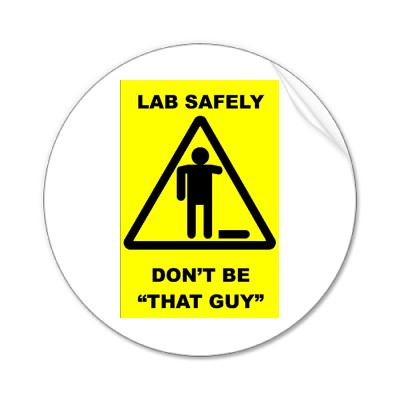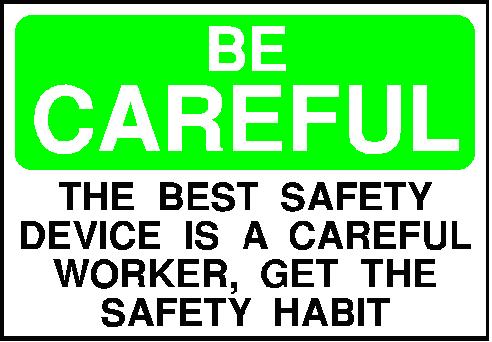Team:IIT Madras/Safety
From 2011.igem.org
| Line 108: | Line 108: | ||
<li> public safety, or | <li> public safety, or | ||
<li> environmental safety?</ul></b> | <li> environmental safety?</ul></b> | ||
| - | <p> | + | <p> |
| - | + | <b>Researcher Safety</b><br/> | |
| + | Chassis: For ensuring researcher safety, we have chosen E.coli as our chassis. They are part of the normal flora of the human gut, and can benefit their hosts by producing vitamin K2,and by preventing the establishment of other pathogenic bacteria within the intestine.<br/> | ||
| + | EtBr: Ethidium bromide is an intercalating agent and is/was commonly used as a fluorescent tag (nucleic acid stain) for agarose gel electrophoresis in our lab. Ethidium bromide is thought to act as a mutagen because it intercalates double stranded DNA (i.e. inserts itself between the strands), deforming the DNA. This could affect DNA biological processes, like DNA replication and transcription. | ||
| + | Hence, we do not wash the gel in EtBr solution. Instead, EtBr is added in minimal concentration to the agar solution before it solidifies. It is strictly observed that gloves are used when handling EtBr or EtBr-containing gel. The gels are discarded considering them to be 'Hazardous Waste'.</br> | ||
| + | <b>Public Safety</b><br/> | ||
| + | All work with live E.coli cells is carried out in the laminar hood that eliminates the possibility of any GMO from being released out.<br/> | ||
| + | Laboratory has doors for access control, as these GMO should not be readily accessible to unintended personnel.<br/> | ||
| + | Appropriate measures for waste disposal are in place. Waste is not washed down the sink or thrown into public dust-bins. <br/> | ||
| + | <b>Environment Safety</b> | ||
| + | All contaminated waste is treated as 'Bio-Hazardous Waste' and is decontaminated before being put into a red trash bag or a sealed medical waste box. The biohazard bag is placed in a pre-chosen area for pick up.<br/> | ||
| + | We believe extensively in the three 'R's - Reduce, Reuse and Recyle. By considering these constraints, we have learnt to plan our experiments better. <br/> | ||
| + | </ul> | ||
</p> | </p> | ||
| Line 134: | Line 145: | ||
4. Do you have any other ideas how to deal with safety issues that could be useful for future iGEM competitions? How could parts, devices and systems be made even safer through biosafety engineering?</b> | 4. Do you have any other ideas how to deal with safety issues that could be useful for future iGEM competitions? How could parts, devices and systems be made even safer through biosafety engineering?</b> | ||
| - | <p> | + | <p> Antibiotic resistance is a public health problem of increasing magnitude, and finding effective solutions to address this problem is a critical focus of CDC activities.[1] Decreasing the susceptibility of recombinant cells to antibiotics proves to be a high risk to the environment.[2] Our new idea is to use proteorhodopsin construct as a tool for selecting transformed mutants. We are designing a new plasmid that does not contain antibiotic resistant gene. Instead it will have our synthetic construct to serve the same purpose. We are introducing a positive control as the cell growth is aided rather than hindered as in the case of antibiotics. We envisage that this make antibiotic based screening technique obsolete. |
</p> | </p> | ||
| + | <hr/> | ||
| + | <p>Refrences</p><br/> | ||
| + | <ul> | ||
| + | <li>Cupillard, L. et al., 2005. Impact of plasmid supercoiling on the efficacy of a rabies DNA vaccines to protect cats. Vaccine 23: 1910-1916.</li> | ||
| + | <li>JM Tiedje et al., 1989. The planned introduction of genetically engineered organisms: Ecological considerations and recommendations Ecology, 70(2), 1989, pp. 298-315</li> | ||
| + | </ul> | ||
</html> | </html> | ||
Revision as of 23:38, 2 September 2011
Contents |
Safety
Experiments were conducted in the Undergraduate lab of the Dept. Of Biotechnology at IIT Madras. The lab cohered to the standards for a biosafety 1 lab according to the Centers for Disease Control and Prevention,Atlanta. Biosafety Level 1 is suitable for work involving well-characterized agents not known to consistently cause disease in immunocompetent adult humans, and present minimal potential hazard to laboratory personnel and the environment. BSL-1 laboratories are not necessarily separated from the general traffic patterns in the building. Work is typically conducted on open bench tops using standard microbiological practices. Special containment equipment or facility design is not required, but may be used as determined by appropriate risk assessment. Laboratory personnel must have specific training in the procedures conducted in the laboratory and must be supervised by a scientist with training in microbiology or a related science.
Standard Microbiological Practices
- Statement of Purpose (SOP) have been developed and are kept for easy access which enlists all the safety measures each experiment should be abided for.
- Access to the laboratory is limited or restricted at the discretion of the laboratory director when experiments or work with cultures and specimens are in progress.
- Persons wash their hands after they handle viable materials, after removing gloves, and before leaving the laboratory.
- Eating, drinking, smoking, handling contact lenses, applying cosmetics, and storing food for human use are not permitted in the work areas. Persons who wear contact lenses in laboratories should also wear goggles or a face shield. Food is stored outside the work area in cabinets or refrigerators designated and used for this purpose only.
- Mouth pipetting is prohibited; mechanical pipetting devices are to be used.
- Policies for the safe handling of sharps are instituted.
- All procedures are performed carefully to minimize the creation of splashes or aerosols.
- Work surfaces are decontaminated at least once a day and after any spill of viable material.
- All cultures, stocks, and other regulated wastes are decontaminated before disposal by an approved decontamination method such as autoclaving. Materials to be decontaminated outside of the immediate laboratory are to be placed in a durable, leakproof container and closed for transport from the laboratory. Materials to be decontaminated outside of the immediate laboratory are packaged in accordance with applicable local, state, and federal regulations before removal from the facility.
Safety Equipment (Primary Barriers)
- Special containment devices or equipment such as a biological safety cabinet is generally not required for manipulations of agents assigned to Biosafety Level 1.
- It is recommended that laboratory coats, gowns, or uniforms be worn to prevent contamination or soiling of street clothes.
- Gloves should be worn if the skin on the hands is broken or if a rash is present. Alternatives to powdered latex gloves should be available.
- Protective eyewear should be worn for conduct of procedures in which splashes of microorganisms or other hazardous materials is anticipated.
Laboratory Facilities (Secondary Barriers)
- Laboratory has doors for access control.
- Laboratory contains a sink for hand washing.
- The laboratory is designed so that it can be easily cleaned.
- Bench tops are impervious to water and are resistant to moderate heat and the organic solvents, acids, alkalis, and chemicals used to decontaminate the work surface and equipment.
- Laboratory furniture is capable of supporting anticipated loading and uses. Spaces between benches, cabinets, and equipment are accessible for cleaning.
- Laboratory has no windows that open to the exterior.
- We have an accesible compartment in the lab for MSDS(Materials Safety Data Sheet) where in we have a roster of all the chemicals and what needs to be done in case of accident.
Simple Questions
1. Would any of your project ideas raise safety issues in terms of:
Researcher Safety
Chassis: For ensuring researcher safety, we have chosen E.coli as our chassis. They are part of the normal flora of the human gut, and can benefit their hosts by producing vitamin K2,and by preventing the establishment of other pathogenic bacteria within the intestine.
EtBr: Ethidium bromide is an intercalating agent and is/was commonly used as a fluorescent tag (nucleic acid stain) for agarose gel electrophoresis in our lab. Ethidium bromide is thought to act as a mutagen because it intercalates double stranded DNA (i.e. inserts itself between the strands), deforming the DNA. This could affect DNA biological processes, like DNA replication and transcription.
Hence, we do not wash the gel in EtBr solution. Instead, EtBr is added in minimal concentration to the agar solution before it solidifies. It is strictly observed that gloves are used when handling EtBr or EtBr-containing gel. The gels are discarded considering them to be 'Hazardous Waste'.
Public Safety
All work with live E.coli cells is carried out in the laminar hood that eliminates the possibility of any GMO from being released out.
Laboratory has doors for access control, as these GMO should not be readily accessible to unintended personnel.
Appropriate measures for waste disposal are in place. Waste is not washed down the sink or thrown into public dust-bins.
Environment Safety
All contaminated waste is treated as 'Bio-Hazardous Waste' and is decontaminated before being put into a red trash bag or a sealed medical waste box. The biohazard bag is placed in a pre-chosen area for pick up.
We believe extensively in the three 'R's - Reduce, Reuse and Recyle. By considering these constraints, we have learnt to plan our experiments better.
2. Do any of the new BioBrick parts (or devices) that you made this year raise any safety issues? If yes,
- did you document these issues in the Registry?
- how did you manage to handle the safety issue?
- How could other teams learn from your experience?
No. All biobricks made and will be made according to the safety guidelines by Centers for Disease Control and Prevention.
3. Is there a local biosafety group, committee, or review board at your institution?
- If yes, what does your local biosafety group think about your project?
- If no, which specific biosafety rules or guidelines do you have to consider in your country?
Yes, our project has the backing of the dept of biotechnology, IIT Madras. They have been provided us with Biosafety level 1 facilities for all our experimental work.
4. Do you have any other ideas how to deal with safety issues that could be useful for future iGEM competitions? How could parts, devices and systems be made even safer through biosafety engineering?
Antibiotic resistance is a public health problem of increasing magnitude, and finding effective solutions to address this problem is a critical focus of CDC activities.[1] Decreasing the susceptibility of recombinant cells to antibiotics proves to be a high risk to the environment.[2] Our new idea is to use proteorhodopsin construct as a tool for selecting transformed mutants. We are designing a new plasmid that does not contain antibiotic resistant gene. Instead it will have our synthetic construct to serve the same purpose. We are introducing a positive control as the cell growth is aided rather than hindered as in the case of antibiotics. We envisage that this make antibiotic based screening technique obsolete.
Refrences
- Cupillard, L. et al., 2005. Impact of plasmid supercoiling on the efficacy of a rabies DNA vaccines to protect cats. Vaccine 23: 1910-1916.
- JM Tiedje et al., 1989. The planned introduction of genetically engineered organisms: Ecological considerations and recommendations Ecology, 70(2), 1989, pp. 298-315
 "
"



